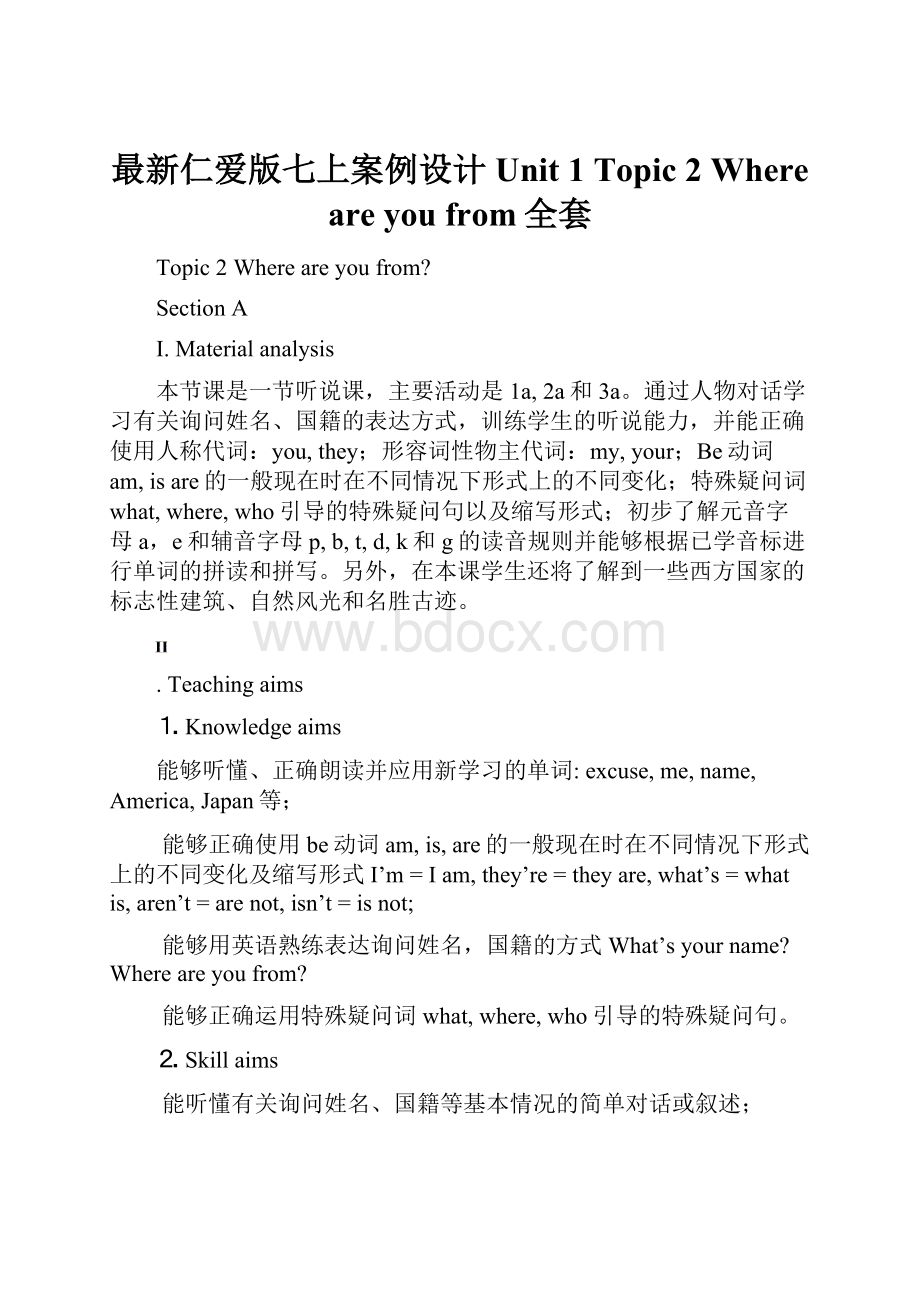最新仁爱版七上案例设计Unit 1Topic 2Where are you from全套.docx
《最新仁爱版七上案例设计Unit 1Topic 2Where are you from全套.docx》由会员分享,可在线阅读,更多相关《最新仁爱版七上案例设计Unit 1Topic 2Where are you from全套.docx(30页珍藏版)》请在冰豆网上搜索。

最新仁爱版七上案例设计Unit1Topic2Whereareyoufrom全套
Topic2Whereareyoufrom?
SectionA
Ⅰ.Materialanalysis
本节课是一节听说课,主要活动是1a,2a和3a。
通过人物对话学习有关询问姓名、国籍的表达方式,训练学生的听说能力,并能正确使用人称代词:
you,they;形容词性物主代词:
my,your;Be动词am,isare的一般现在时在不同情况下形式上的不同变化;特殊疑问词what,where,who引导的特殊疑问句以及缩写形式;初步了解元音字母a,e和辅音字母p,b,t,d,k和g的读音规则并能够根据已学音标进行单词的拼读和拼写。
另外,在本课学生还将了解到一些西方国家的标志性建筑、自然风光和名胜古迹。
.Teachingaims
⒈Knowledgeaims
能够听懂、正确朗读并应用新学习的单词:
excuse,me,name,America,Japan等;
能够正确使用be动词am,is,are的一般现在时在不同情况下形式上的不同变化及缩写形式I’m=Iam,they’re=theyare,what’s=whatis,aren’t=arenot,isn’t=isnot;
能够用英语熟练表达询问姓名,国籍的方式What’syourname?
Whereareyoufrom?
能够正确运用特殊疑问词what,where,who引导的特殊疑问句。
⒉Skillaims
能听懂有关询问姓名、国籍等基本情况的简单对话或叙述;
能运用图文就表示询问姓名、国籍等的基本情况的话题进行简单的交流;
能根据已学音标的初步知识拼读单词;
能正确地朗读对话,并能注意语音语调;
能写出询问对方基本情况的简单句。
⒊Emotionalaims
能够与同学积极合作,参与课堂活动,大胆实践,培养友好互助的精神;
能有兴趣用所学的功能句进行口头对话;
使学生乐于接触并了解异国文化。
Ⅲ.Thekeypointsanddifficultpoints
⒈Keypoints
正确使用表示询问姓名、国籍等的表达方式;
正确使用人称代词:
you,they以及形容词性物主代词:
my,your;
正确使用be动词am,is,are的一般现在时在不同情况下形式上的不同变化;
掌握缩写形式I’m=Iam,they’re=theyare,what’s=whatis,aren’t=arenot,isn’t=isnot;
掌握元音字母a,e及辅音字母p,b,t,d,k,g的读音规则。
⒉Difficultpoints
特殊疑问词what,where,who引导的特殊疑问句及缩写形式;
Be动词am,is,are的应用;
元音字母a,e及辅音字母p,b,t,d,k,g的读音规则。
Ⅳ.Learningstrategies
运用图片教学能帮助学生理解和掌握教学内容。
Ⅴ.Teachingaids
录音机、教学挂图、闪卡、黑板和多媒体。
Ⅵ.Teachingprocedures
Step
Interactionpatterns
Studentactivity
Teacheractivity
Introduction
(3minutes)
1.Thewholeclassworkandindividualwork.
1.Thestudentsreplytotheteacher.
T:
Hello!
Good
morning.
Ss:
Hello!
Good
morning.
Theteacherwalkstoonestudent.
T:
Hello!
Are
you…?
S1:
Yes.Iam.
1.Theteachergreetswithstudents.
Presentation
(13minutes)
1.Individualwork
andthewholeclasswork.
2.Individualwork.
3.Individualworkandthewholeclasswork.
4.Thewholeclasswork.
5.Individualwork.
1.Do1a.Thestudentanswerstheteacher“No,I’mnot.I’m…”Studentslookandlistentotheteachercarefully;
Studentsmakesentencesusingitonebyone.
2.Thestudentanswers“Mynameis…”
3.Thestudentanswers“I’mfromCanada.”
Thewholeclassreadthenewwordforseveraltimes.
4.Thethirdstudentanswers,“No,I’mnot.I’mfromAmerica.”
Thewholeclassreadthenewwordforseveraltimes.
5.Studentslookatthepictureandlistentothetapecarefully;
Followthetapetoread1afortwotimes.
1.Walktonextstudentandsay“Excuseme,areyou…?
”(老师将解释excuseme,常用于口语中,意为“劳驾,打扰一下。
”)
Repeatitforseveraltimes;
Writedownthesentencesontheblackboardandsay“Yes,Iam.”(是肯定回答)“No,I’mnot.”(是否定回答,注意:
肯定回答时Iam.不能缩写,否定回答时,Iam可缩写)
Andsay,“I’mDenny.MynameisDenny.”Writedownontheblackboard:
“I’mDenny.=MynameisDenny.”
Letstudentsuse“Mynameis…”tomakesentencesonebyone.
2.Walktoonestudentandsay“MynameisDenny.What’syourname?
”(老师解释:
你叫什么名字?
What’s=Whatis)(Writedownontheblackboard).
3.Walktoanotherstudentandsay“I’mfromChina,”(老师解释:
我来自中国)“Whereareyoufrom?
”(你来自哪儿?
)andshowapictureofCanada(如加拿大的电视塔);Thenteachthenewword“Canada”forseveraltimes.
4.Walktothethirdstudentandask“AreyoufromCanada,too?
”andshowapictureofAmerica(如美国的自由女神像);Thenteachthenewword“America”forseveraltimes.
5.Showtheteachingpictureof1a,thenletstudentslookatthepictureandlistentothetapecarefullyforthefirsttime;
Thenplaythetapeagainandletstudentsfollowitfortwotimes.
Consolidation
(12minutes)
1.Thewholeclassworkandpairwork.
2.Thewholeclassworkandindividualwork.
1.Do1c.Readthewordaftertheteacherforthreetimes;
Workinpairsandmakeupnewconversationswiththecountrynames;Thentwopairsshowtheirconversationstothestudents.
2.Do1b.Studentsguess,listenandnumberthepictures;
Thenlistentothetapeagainandmatchthenameswiththecountries,andonestudentcheckstheanswers;Thenreadafterthetape.
1.ShowthepictureofJapan(如日本富士山图)andteachtheword“Japan”forthreetimes;
Pointoutothercountrynames(eg.China,theUSA,theUK),thenletstudentsworkinpairsandmakeupnewconversationswiththecountrynamesfor1minute.
2.Showthepicturesof1bandexplaintheculturalbackgroundofthesepictures;
Playthetapeagainandchooseonestudenttochecktheanswers;
Thenshowthelisteningmaterialandplaythetape.
Practice
(12minutes)
1.Thewholeclassindividualworkandpairwork.
2.Pairwork.
3.Thewholeclassworkandgroupwork.
1.Do2a.Followtheteacher,“TheyareMariaandJane.”
Thenlistenandcompletetheconversationby
themselves;
StudentsreadA,andthenpracticetheconversationinpairs;
Thentwostudentssharetheconversationwiththewholeclass.
2.Do2b.Completetheconversationinpairsandtwostudentsshowtheiranswers.
3.Do3a.Listenandread“Japan”together;
Readaftertheteachertogetherandimitatetheteacher;
Readthewordtogether;
Discussthepronunciationingroups;
Twogroupstrytoreadthewords;
Somestudentsmakeasummaryaboutthethepronunciationofa.Inthesameway,theysummarizethepronunciationofe;
Listentothewordsof3aandrepeat.
1.Pointoutthepictureof2aandsay,“Whoarethey?
”(老师指着幻灯片上的MariaandJane.她们是谁?
)“TheyareMariaandJane.Theyare=they’re”(writedownitontheblackboard);
Letstudentsopentheirbooks,andthenlistenandcompletetheconversationof2a;
Readtheconversationinroles.TheteacherreadsBandthengivesstudents1minutetopracticetheconversationinpairsandchoosesonepairtoshowtheconversation.
2.Givestudents1minutetocompletetheconversationinpairsandchoosetwostudentstoshowtheiranswers.
3.Pointoutacardwithaword“Japan”onitandreaditout;
Showthenextcardswith“gap,pat,pet”onthemandreadthemout;
Explain“p是清辅音也是爆破音”(老师可用一张纸做演示,让学生直观感触p的发音特点)(老师可用同样的方法教授b,t,d,k,g的读音)
Showacardwith“name”onitandletstudentsreadtheword;
Showothercardswith“dategatetape”onthem,letstudentsdiscussthepronunciationingroups;
Choosetwogroupstoreadthewords;
Letstudentsmakeasummaryaboutthepronunciationofa.
(Intheway,teach/2//i:
//e/)(老师可分别用学过的单词,如am,see,welcome);
Thenplaythetape.
Production
(5minutes)
1.Groupworkand
thewholeclasswork.
1.Studentsmakeupashortconversationingroupsandtwogroupsshowtheirconversations;
Studentslistentotheteacher.
1.Letstudentsusethesentences“What’syourname?
Whereareyoufrom?
Areyou…?
Whoarethey?
They’re…Wherearetheyfrom?
Theyarefrom…”tomakeupashortconversationingroups(1min)andchoosetwogroupstoshowtheirconversations;
Makeasummaryabouttheshow.
2.Assignhomework:
Reviewthekeysentenceswehavelearnt;
Readandrecite1a;
Copyeverywordoneline;
PreviewthenewwordsandSectionB-1a.
Teachingreflection:
本节课利用教学挂图、师生互动等教学手段完成本课的教学任务。
其中,在由单数句型I’mfrom…向复数句型They’refrom…转换时学生出现了问题,此外,要加强be动词的应用;由于本课内容较多,为了减轻学生的负担,把3b的教学内容调整到SectionB中学习。
Ⅶ.Blackboarddesign
Whereareyoufrom?
SectionA
1.What’syourname?
CanadaSounds:
2.Whereareyoufrom?
Japan/V//2//1//e/
3.AreyoufromCanada,too?
America/p//b//t//d//k//G/
4.—Excuseme,areyou…?
England
—Yes,Iam./No,I’mnot.
5.—Whoarethey?
—TheyareMariaandJane.
6.theyare=they’re
SectionB
Ⅰ.Materialanalysis
本节课是在SectionA的基础上拓展学习新知识,主要活动是1a和2a。
通过看、听、说,复习询问姓名、国籍的表达方式,并进一步学习对第三人称基本信息的询问“Whoisshe/he?
”,“She/Heis…”,“Whereisshe/hefrom?
”此外,学生还会了解到英美国家在姓名表达方式上与中国的不同,老师将利用图片和师生互动展开教学,最后,通过学唱英文歌巩固本课的询问国籍表达及国家名称。
Ⅱ.Teachingaims
1.Knowledgeaims
能够掌握并应用新学习的单词:
look;
能够正确使用be动词am,isare的一般现在时在不同情况下形式上的不同变化;
能够正确使用人称代词:
she,he;
能够用英语熟练表达询问姓名、国籍的方式:
Whoisshe/he?
She/Heis….
Whereisshe/hefrom?
She/Heisfrom…Isshe/hefrom…?
Yes,she/heis./No,she/heisn’t.
能够正确运用特殊疑问词where,who引导的特殊疑问句。
2.Skillaims
能听懂有关询问姓名、国籍等基本情况的简单对话或叙述;
能运用图文就表示询问姓名、国籍等基本情况的话题进行简单的交流;
能正确地朗读对话,并能注意语音语调;
能正确使用英文句子的书写格式和单词的大写规则。
3.Emotionalaims
能够与同学积极合作,参与课堂活动,大胆实践,培养友好互助的精神;
能有兴趣用所学的功能句进行口头对话;
使学生乐于接触并了解异国文化。
Ⅲ.Thekeypointsanddifficultpoints
1.Keypoints
正确使用表示询问姓名、国籍等的表达方法;
正确使用人称代词:
she,he
掌握be动词am,is,are的一般现在时在不同情况下形式上的不同变化;
掌握缩写形式Who’s=Whois;Where’s=Whereis
2.Difficultpoints
特殊疑问词where,who引导的特殊疑问句;
Be动词am,is,are的应用;
单数句型和复数句型的互换。
Ⅳ.Learningstrategies
通过学习中西方姓名书写顺序的不同,了解中西方文化的差异。
Ⅴ.Teachingaids
多媒体、黑板、教学挂图和录音机。
Ⅵ.Teachingprocedures
Step
Interactionpatterns
Studentactivity
Teacheractivity
Introduction
(5minutes)
1.Thewholeclasswork.
2.Individualwork.
1.Respondtheteacher.
T:
“Hello!
Good
morning,Nicetomeetyou.”
Ss:
“Hi,Good
morning.Nicetomeetyou,too.”
2.T:
“Excuseme,areyou…”
S1:
“Yes,Iam.”
Theteacherwalkstonextstudent.
T:
“Excuseme,areyou…”
S2:
“No,I’mnot.Iam…”;
Thestudentanswers;“Theyare…and…”;
Studentsreadthewordcardsonebyone.
1.Greetwithstudents.
2.Walktoonestudentandgreetwithhim/her;
Pointtotwostudentsandaskonestudent:
“Whoarethey?
”;
Showsomewordcards.(含有元音字母a,e以及辅音p,b,t,d,k,g)Letstudentstrytoreadthemonebyone.
Presentation
(15minutes)
1.Thewholeclasswork,pairworkandindividualwork.
2.Thewholeclasswork.
1.Do2a.Thestudentsanswer,“SheisDengYaping=She’sDengYaping”;
Thestudentsanswer,“SheisfromChina.=She’sfromChina.”;
Studentsmakeuptheirconversationsinpairs;
T:
“Look!
Whoishe?
(chooseoneto
answer)”
S1:
“HeisStephenHawking.(He
is=He’s)”
T:
“IshefromChina,too?
”
Ss:
“No,heisn’t.”
T:
“Whereishefrom?
”(chooseonetoanswer)
S2:
“HeisfromEngland.”;Studentsmakeuptheirconversationsinpairs.
2